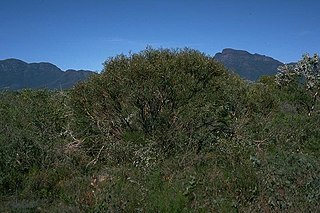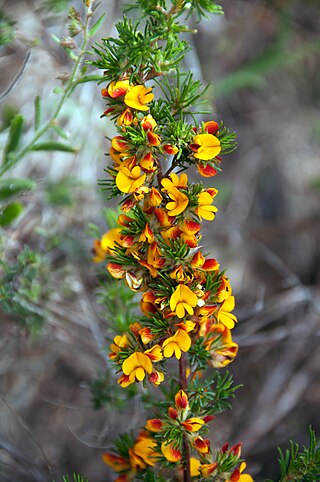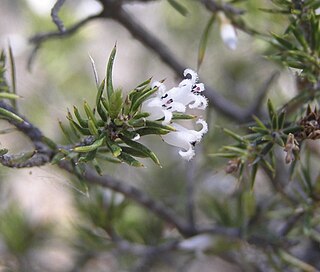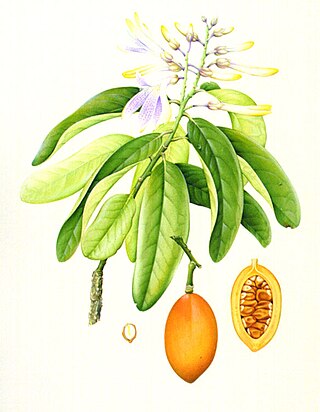
Pandanus spiralis is a small tree in the family Pandanaceae native to northern Australia. It is commonly called pandanus, spring pandanus, screw palm or screw pine, although it is neither a palm nor a pine.

Astrotricha is a genus of shrubs in the ivy family Araliaceae endemic to Australia. It contains about 20 described species and a number of undescribed ones, and the genus is mostly confined to Victoria, New South Wales and Queensland with one species found in Western Australia.

Neolitsea dealbata, also known as white bolly gum, hairy-leaved bolly gum, or simply bolly gum, is a shrub or small tree in the laurel family Lauraceae which is native to New South Wales and Queensland in Australia.

Alpinia caerulea, commonly known as native ginger or Australian ginger, is an understorey perennial herb in the family Zingiberaceae which grows in rainforest, gallery forest and wet sclerophyll forest in eastern Australia.

Phaleria clerodendron, commonly known as scented daphne, scented phaleria or rosy apple, is an evergreen tree or tall shrub in the family Thymelaeaceae. It is endemic to the rainforests of north-eastern Queensland, Australia.

Seringia hillii is a species of flowering plant in the mallow family and is endemic to eastern Australia. It is a single-stemmed shrub with hairy new growth, egg-shaped leaves and usually mauve flowers arranged in groups of 2 to 9.

Eucalyptus pachyloma, commonly known as Kalgan Plains mallee, is a species of mallee that is native to Western Australia. It has smooth, greyish bark, lance-shaped adult leaves, flower buds in groups of between seven and thirteen, white to cream-coloured flowers and conical to cup-shaped fruit.

Platysace commutata is a shrub that is endemic to the south-west of Western Australia. It has linear leaves and white to cream-coloured or blue flowers.

Muellerina bidwillii, common name Cypress-pine mistletoe, is a hemiparasitic aerial shrub in the family Loranthaceae. The species is endemic to New South Wales and Queensland.

Asterolasia correifolia is a species of erect shrub that is endemic to eastern Australia. It has white to brown star-shaped hairs on its stems, lance-shaped to elliptical leaves densely covered with white star-shaped hairs on the lower surface, and white to cream-coloured or yellow flowers arranged in umbels of four to ten or more in leaf axils, the back of the petals densely covered with white hairs.

Goodenia benthamiana, commonly known as small-leaf goodenia, is a species of flowering plant in the family Goodeniaceae and is endemic to south-eastern Australia. It is an aromatic undershrub with stem-clasping, egg-shaped to elliptic leaves with toothed edges, and yellow flowers arranged singly or in groups of up to three in leaf axils, with leaf-like bracteoles at the base.

Pultenaea acerosa, commonly known as bristly bush-pea, is a species of flowering plant in the family Fabaceae and is endemic to south-eastern continental Australia. It is a rigid, much-branched shrub with glabrous, grooved, needle-shaped leaves and yellow flowers with red veins.

Styphelia mitchellii is a species of flowering plant in the family Ericaceae family and is endemic to Queensland. It is a shrub with sharply-pointed, narrowly oblong leaves and white, tube-shaped flowers.

Mackinlaya macrosciadea, commonly known as mackinlaya or blue umbrella, is a plant in the carrot, fennel and parsley family Apiaceae, found in the Northern Territory and Queensland, Australia.

Cleistanthus apodus, commonly known as the weeping Cleistanthus, is a tree in the family Phyllanthaceae native to New Guinea and northeast Queensland. It was first described in 1873 by the English botanist George Bentham in his seven-volume book Flora Australiensis.

Heptapleurum ellipticum, commonly known in Australia as the climbing umbrella tree, is a plant in the family Araliaceae native to the Indian subcontinent, Indochina, Malesia, Papuasia and Australia.

Platysace filiformis is a species of flowering plant in the family Apiaceae and is endemic to the south-west of Western Australia. It is an erect or sprawling, perennial herb or shrub with flat, winged stems with few leaves and white or cream-coloured flowers arranged in compound umbels.

Diploglottis bernieana, commonly known as Bernie's tamarind or large leaf tamarind, is a plant in the maple and lychee family Sapindaceae. It was first described in 1987 by the Australian botanist Sally T. Reynolds and is found only the Wet Tropics region of northeastern Queensland, Australia.

Aglaia ferruginea, commonly known as rusty boodyarra or rusty Aglaia, is a plant in the mahogany family Meliaceae that is native to northern Queensland, Australia. The name A. tomentosa has been misapplied to the species in the past.

Xanthophyllum fragrans, commonly known as fragrant boxwood, is an evergreen plant in the family Polygalaceae found only in the Wet Tropics bioregion of Queensland, Australia.
























